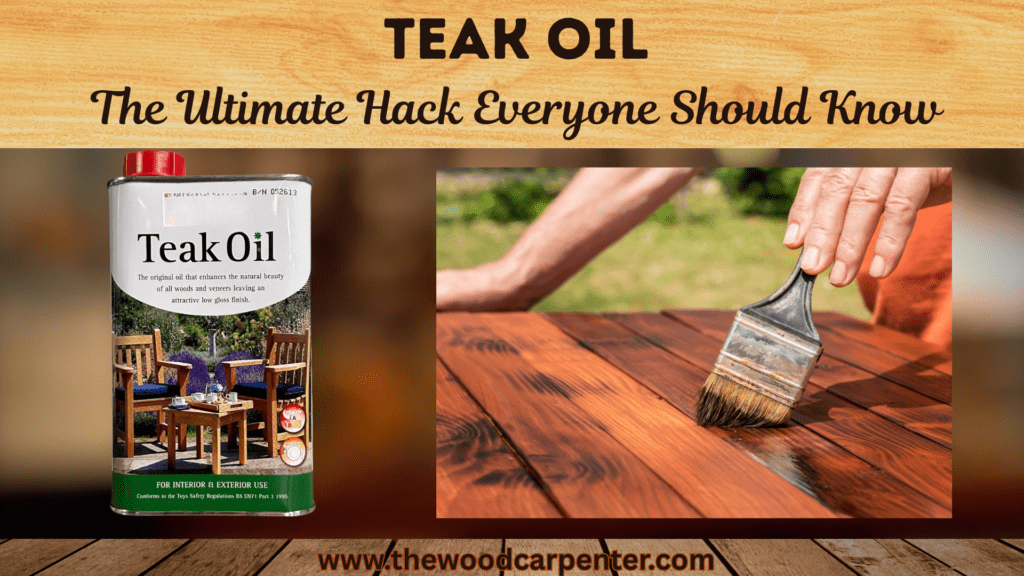
Teak oil is a popular wood finish used to protect and improve the look of teak and other hardwoods. It’s well known for keeping wood healthy, adding beauty, and giving lasting protection—whether for outdoor or indoor furniture, especially those made from exotic woods.
In this guide, we’ll explain what teak oil is, its benefits, how to apply it, how to maintain it, and answer some common questions so you can see why it’s one of the best products for wood care.
What is Teak Oil?
Teak oil isn’t just one type of oil—it’s a mix of natural oils like linseed oil, tung oil, rapeseed oil, and sometimes other plant-based oils and additives. It’s made to soak into hardwood, especially teak, to protect it from damage.
Unlike varnish or lacquer, which sits on the surface, teak oil goes deep into the wood grain. It replaces the natural oils that the wood loses over time from sunlight, weather, and aging. This helps bring out the wood’s rich color and beautiful grain while giving it long-lasting protection.
What’s in Teak Oil?
Natural Oil Blend – Most teak oils are made from pure tung oil and linseed oil, which are safe, eco-friendly, and non-toxic. These oils soak into the wood fibers, keeping them flexible and preventing them from becoming brittle.
No Surface Film – Unlike varnish or polyurethane, teak oil doesn’t form a hard layer on top of the wood that can peel or crack. Instead, it sinks into the wood, making it easier to refresh with a quick reapplication.
Also read:
Spar Urethane vs Polyurethane: Which One Will Save Your Wood ?
Stain vs. Varnish: Which Should You Use ?
UV Protection – Many teak oils have UV blockers that slow down fading and discoloration from sunlight.
Moisture Resistance – By filling the wood’s pores, teak oil creates a water-resistant barrier that helps stop warping and cracking.
Matte Finish – Once dry, teak oil leaves a natural matte or low-sheen look, bringing out the wood’s grain and warm golden or honey tones.
Benefits of Using Teak Oil
Brings Out Natural Beauty – Teak oil restores dull or weathered wood by deepening its golden-brown color and showing off its natural grain.
Protects Against Weather Damage – It replaces lost oils to prevent cracking, drying, and warping caused by sun, rain, and changing temperatures. It also stops the wood from turning grey outdoors.
Resists Moisture and Water – By soaking deep into the wood, teak oil helps block moisture, preventing swelling, rot, and mildew. This is especially important for outdoor furniture, decks, and boats.
Fights Mold and Mildew – Its protective layer helps keep fungus, mold, and mildew from growing—ideal for damp or humid environments.
Easy to Use and Maintain – Applying teak oil is simple and doesn’t require a lot of prep work. You can reapply it easily without removing the old layer—just clean the surface and re-oil as needed.
Safe and Non-Toxic – Many teak oils are made from natural, food-safe ingredients, making them safe for indoor use, including on toys and kitchen furniture.
Advantages and Considerations
Advantages:
- Enhances wood beauty naturally
- Long-lasting protection without peeling
- Easy to apply and maintain
- Provides moisture and UV protection
- Non-toxic and eco-friendly
Considerations:
- Multiple coats needed initially for full protection
- Requires periodic reapplication depending on exposure
- Not a replacement for varnish if a hard film finish is desired
- May darken some light woods slightly
Common Uses of Teak Oil
- Outdoor teak garden furniture
- Wooden decks and marine teak surfaces
- Doors, window frames, and garden fencing
- Indoor hardwood furniture and cabinetry
- Exotic hardwoods like mahogany, rosewood, and more
- Turned wood and wooden toys
Also read:
Teak Oil vs Tung Oil: Which Wood Finish is Best for You?
How to Apply Teak Oil
Preparation – Make sure the wood is clean, dry, and free from dust or old finishes. If needed, use a wood or teak cleaner to remove dirt, grime, or old residues.
Tools You’ll Need – Use a foam brush, lint-free cloth, or soft bristle brush for the best results.
Applying the Oil – Rub or brush the oil generously onto the wood, following the direction of the grain. Let it soak in for about 15 minutes, then wipe away any extra oil so it doesn’t become sticky.
Drying Time – Let the wood dry for 4–6 hours in a cool, well-ventilated area. Avoid applying in direct sunlight or damp weather.
Number of Coats – For bare wood, apply at least three coats, letting each coat dry fully before adding the next. For maintenance, one coat a year (or as needed) is usually enough.
Ongoing Care – Clean the surface with mild soap before reapplying oil. Regular upkeep keeps the wood nourished and protected.
Frequently Asked Questions (FAQs) About Teak Oil
Q1: What is teak oil made of?
A: It’s a mix of natural oils like linseed and tung oil, sometimes with other plant oils and additives to protect hardwood.
Q2: Is teak oil only for teak wood?
A: No. Despite the name, it works on many hardwoods and exotic woods, indoors or outdoors—though it’s not ideal for some woods, like outdoor oak.
Q3: Can teak oil be used outdoors?
A: Yes. It’s great for outdoor furniture and decks because it protects against sunlight, moisture, and weather damage.
Q4: How often should I reapply teak oil?
A: For outdoor furniture, once a year is common. For items that get more wear or weather exposure, reapply every 3–6 months.
Q5: Does teak oil stop wood from turning grey?
A: It slows the greying process but doesn’t completely prevent it. Without oil, teak naturally fades to a silver-grey color over time.
Q6: Is teak oil safe for indoor use?
A: Yes. Most modern teak oils are safe once dry, including on toys and food-contact surfaces, especially if made from natural oils.
Q7: What kind of finish does teak oil give?
A: It leaves a natural matte or soft-sheen finish that highlights the wood’s grain and color without a shiny coating.
Q8: Can teak oil be used on other types of wood?
A: Yes. It works well on many woods, including pine, mahogany, rosewood, and other exotic hardwoods.

